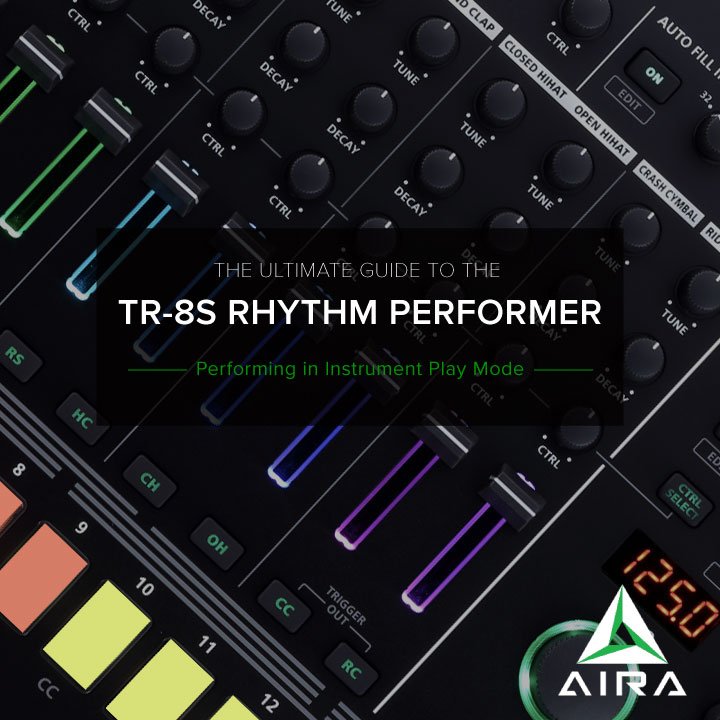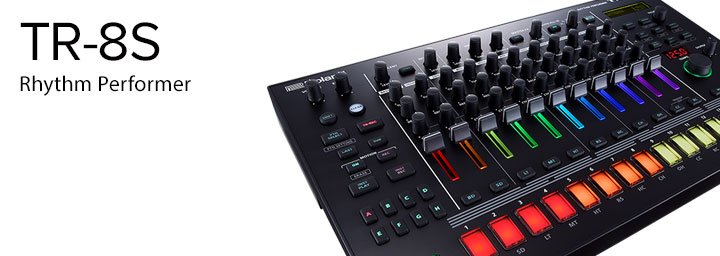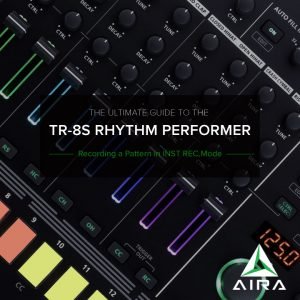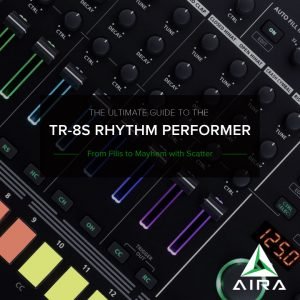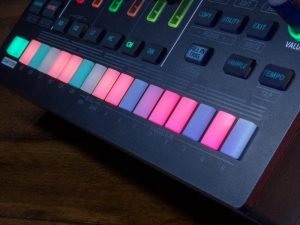- Press the Start/Stop Button to start playing the currently selected Pattern.
- Press Pad [1] to experiment with adding extra Bass Drum hits to the Pattern.
- Press Pad [2] to experiment with adding extra Snare Drum hits to the Pattern.
- Press Pad [8] to experiment with adding extra Closed High Hat hits to the Pattern.
- Press other Pads [1-11] to experiment with adding other extra hits to the Pattern.
Using the INST Pad
The INST Pad is the single velocity sensitive pad located in the lower right corner of the front panel, just above Pad [16]. This Pad plays the currently selected Instrument, as determined by which of the Instrument Select Buttons [BD-RC] is lit. Since the INST Pad is velocity sensitive, you can play louder and softer notes depending on how hard you hit the Pad.
Try playing along with the Pattern using the INST Pad:
- Press the Start/Stop Button to start playing the currently selected Pattern.
- Press the BD Button to select the Bass Drum Instrument.
- Play the INST Pad to experiment with adding extra Bass Drum hits to the Pattern.
- Press the SD Button to select the Snare Drum Instrument.
- Play the INST Pad to experiment with adding extra Snare Drum hits to the Pattern.
- Press the HC Button to select the Hand Clap Instrument.
- Play the INST Pad to experiment with adding extra Hand Clap hits to the Pattern.
- Press other Instrument Select Buttons [BD-RC] and play the INST Pad to experiment with adding other extra hits to the Pattern.
Playing Two Instruments At Once
- Press the Start/Stop Button to start playing the currently selected Pattern.
- Press the Variation A Button to choose Variation A.
- Hold the BD Button and press the Clear Button to erase the existing Bass Drum part from Variation A.
- Hold the SD Button and press the Clear Button to erase the existing Snare Drum part from Variation A.
- Now with the SD Button lit, you can play the Snare on the INST Pad with your right hand, and the Bass Drum on Pad [1] with your left hand.
- Experiment with playing the Bass Drum and Snare at the same time. If you’re not sure how to get started, you can play the Bass Drum on the first and third beats, and the Snare on the second and fourth beats. When you have that going, try adding an extra Bass Drum hit here and there until you start to feel a groove. Playing the Snare on the second and the fourth beats can be a good way to anchor your playing, giving you a starting point from which to develop a kick/snare pattern.
- When you’ve got something you like, you can press the INST REC Button and record your Bass Drum and Snare Drum together into Variation A, then press the INST Play Button again to go back into Instrument Play Mode.
Adding Variations to a Pattern
- Press the Start/Stop Button to start playing the currently selected Pattern.
- Turn the Tune Knob of the Bass Drum Track to adjust the Tuning of the Bass Drum as the Pattern plays, turning the Knob to the left to tune the drum lower, and to the right to tune it higher. For example, try tuning the Bass Drum lower for the beginning of the Pattern, then gradually a little higher as the Pattern plays.
- Turn the Tune Knob of the Snare Drum Track to adjust the Tuning of the Snare as the Pattern plays. For Example, try tuning the Snare a little higher for the hit on the second beat, and a little lower for the fourth beat.
- Experiment with the Tune Knobs of other Tracks to find ways to make the Pattern come to life more, as you apply subtle or even more dramatic changes in Tuning.
- Next try the same steps as above, only with the Decay Knobs of the Bass Drum and Snare Drum Tracks, turning the Knob to the right to make the notes last longer and to the right to make them shorter.
- Try turning the Tune and Decay Knobs of a given Track at the same time to see how the tuning and duration of a drum can interact with each other to make the Instrument more dynamic.
- Try experimenting with changing the Tuning and Decay of different Instruments at the same time to find interesting interactions between the Instruments.
PRO TIP
During playback, hold Shift and press the Start/Stop Button to start the Pattern over from the beginning of Variation A. You can also restart playback of any of the currently selected Variations by holding Shift and pressing one of the selected Variation Buttons. This feature works in realtime, so playback resets immediately when you hit the Start/Stop Button or the Variation Button while holding Shift. This is a cool way to remix a Pattern on the fly as the song plays.Article written by Alex Marlowe
 Alex Marlowe is a Composer/Producer, Musician and Consultant based in Melbourne, Australia. Alex has placed music in numerous movies and TV shows, and toured worldwide as a keyboardist with major artists. As a Teacher and Consultant, Alex has worked with platinum songwriters, music editors, producers and composers, and conducted courses in Music Production and Music Software, including at the Songwriting School of Los Angeles. You can find more info, and contact Alex at: www.logicproanswers.com
Alex Marlowe is a Composer/Producer, Musician and Consultant based in Melbourne, Australia. Alex has placed music in numerous movies and TV shows, and toured worldwide as a keyboardist with major artists. As a Teacher and Consultant, Alex has worked with platinum songwriters, music editors, producers and composers, and conducted courses in Music Production and Music Software, including at the Songwriting School of Los Angeles. You can find more info, and contact Alex at: www.logicproanswers.com

